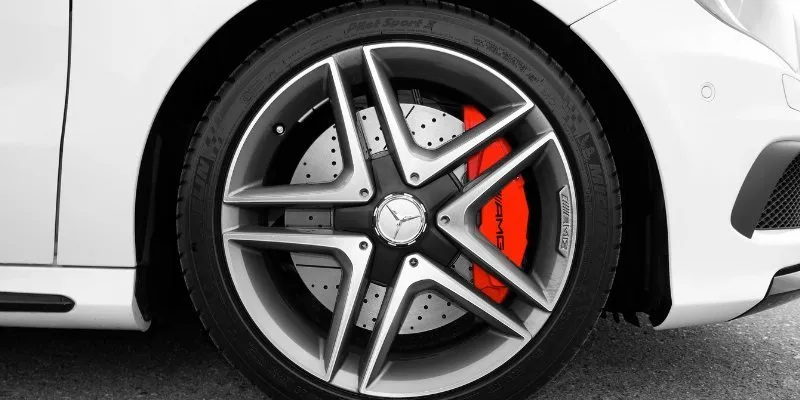Tire Size for 8 Inch Rim

The rim, which is the outer edge of the wheel, must be paired with a tire that fits perfectly to ensure safety, performance, and comfort. For 8-inch rims, the tire options are varied, each with its own set of benefits.
In this article, we’ll explore the different tire sizes available for 8-inch rims, helping you make an informed decision.
What Are 8-Inch Rims?
Before diving into the tire sizes, let’s first clarify what we mean by “8-inch rims.” The “8-inch” refers to the width of the rim, not its diameter.
This width measurement is crucial because it determines the range of tire widths that can safely and effectively be mounted on the rim. Using a tire that’s too narrow or too wide for the rim can lead to poor handling, increased wear, and even safety hazards.
Why Rim Size Matters
The rim size directly influences the tire’s fitment, which in turn affects the vehicle’s overall performance. A tire that fits snugly on an 8-inch rim will provide optimal contact with the road, offering better grip, handling, and stability.
Conversely, a tire that doesn’t fit well can cause issues such as uneven wear, poor fuel efficiency, and compromised safety.
Tire Size Terminology Explained
Before we discuss specific tire sizes, it’s important to understand the meaning of tire size designations. For example, a tire size might be listed as 165/80R8. Here’s what each part means:
- 165: This is the tire’s width in millimeters. It’s the distance from one sidewall to the other.
- 80: This number represents the aspect ratio, which is the height of the tire’s sidewall as a percentage of its width. In this case, the sidewall height is 80% of the tire’s width.
- R: This stands for radial construction, the most common type of tire construction today.
- 8: This is the diameter of the rim in inches.
Understanding this breakdown will help you better comprehend how each tire size fits and functions on an 8-inch rim.
List of Tire Sizes for 8-Inch Rims
Let’s take a closer look at some of the most common tire sizes for 8-inch rims, exploring what each size has to offer.
165/80R8: Narrow and Tall
The 165/80R8 is a narrow tire with a relatively tall sidewall. This size is often used in situations where space is at a premium or where a higher aspect ratio is needed for a smoother ride.
The taller sidewall helps absorb bumps and provides a comfortable ride, making it a good choice for light vehicles or trailers. However, because it’s narrow, it may not offer as much grip as wider tires, particularly in sharp turns or on wet surfaces.
175/70R8: A Balanced Option
The 175/70R8 strikes a balance between width and sidewall height. It offers a slightly wider footprint than the 165/80R8, which can improve grip and handling.
At the same time, the 70% aspect ratio still provides some cushioning against road imperfections. This size is versatile and can be a good fit for a variety of vehicles, from compact cars to small trailers.
185/60R8: Lower Profile for Better Handling
Moving to the 185/60R8, we see a tire with a lower aspect ratio, which means a shorter sidewall. This results in better handling and more responsive steering, particularly on smooth roads.
The wider tread also increases the contact patch with the road, improving traction. However, the shorter sidewall can make the ride feel a bit stiffer, especially on rough roads.
195/55R8: Wider Footprint, Sportier Feel
The 195/55R8 is a step up in width, providing an even larger contact patch. This tire size is often chosen for its sporty feel, offering enhanced grip and improved cornering performance.
The 55% aspect ratio means the sidewall is relatively low, contributing to a more direct and connected driving experience. This size is ideal for those who prioritize handling and responsiveness in their vehicle.
205/50R8: Performance-Oriented Choice
The 205/50R8 is designed for those who seek performance. The wider width and lower aspect ratio create a tire that’s all about grip and stability.
This size is often used on vehicles where performance is a priority, such as sporty compact cars or tuned vehicles. The trade-off, however, is a firmer ride, as the shorter sidewall offers less cushioning against road irregularities.
215/45R8: Wider Still, Enhanced Stability
With the 215/45R8, we’re venturing into even wider territory. This tire size offers exceptional stability, particularly at higher speeds.
The low aspect ratio ensures that the tire remains firm and responsive, making it a popular choice for enthusiasts who enjoy spirited driving. However, the ride can be quite firm, and the tire may be more susceptible to damage from potholes or rough terrain.
225/40R8: Maximum Grip for 8-Inch Rims
Finally, the 225/40R8 is the widest and lowest-profile tire on our list. This tire offers the maximum amount of grip and the most responsive handling of all the options.
It’s perfect for high-performance vehicles that need every bit of traction and stability. However, this comes at the cost of ride comfort, as the very low sidewall offers minimal absorption of bumps and shocks.
Choosing the Right Tire for Your Needs
Selecting the right tire size for your 8-inch rims depends on a variety of factors, including your driving style, the type of vehicle, and the conditions in which you typically drive. Here are some tips to help you decide:
- For Comfort: If you prioritize a smooth ride, a tire with a higher aspect ratio, like the 165/80R8 or 175/70R8, might be your best bet. These tires offer more cushioning and can handle rough roads with ease.
- For Handling: If you’re more concerned with sharp handling and a sporty feel, consider a lower-profile tire like the 195/55R8 or 205/50R8. These tires offer better grip and responsiveness.
- For Performance: For those who demand the utmost in performance, the wider and lower-profile 215/45R8 or 225/40R8 will provide the maximum grip and stability, especially in high-speed situations.
Conclusion
Choosing the right tire size for your 8-inch rims is about balancing your needs and preferences with the technical requirements of your vehicle. Whether you’re looking for comfort, handling, or performance, there’s a tire size on this list that will fit your needs.
Remember to consider the type of driving you do most often and select a tire that complements your style and your vehicle’s characteristics.
By making an informed choice, you’ll ensure that your vehicle performs at its best and provides a safe, comfortable, and enjoyable driving experience.

